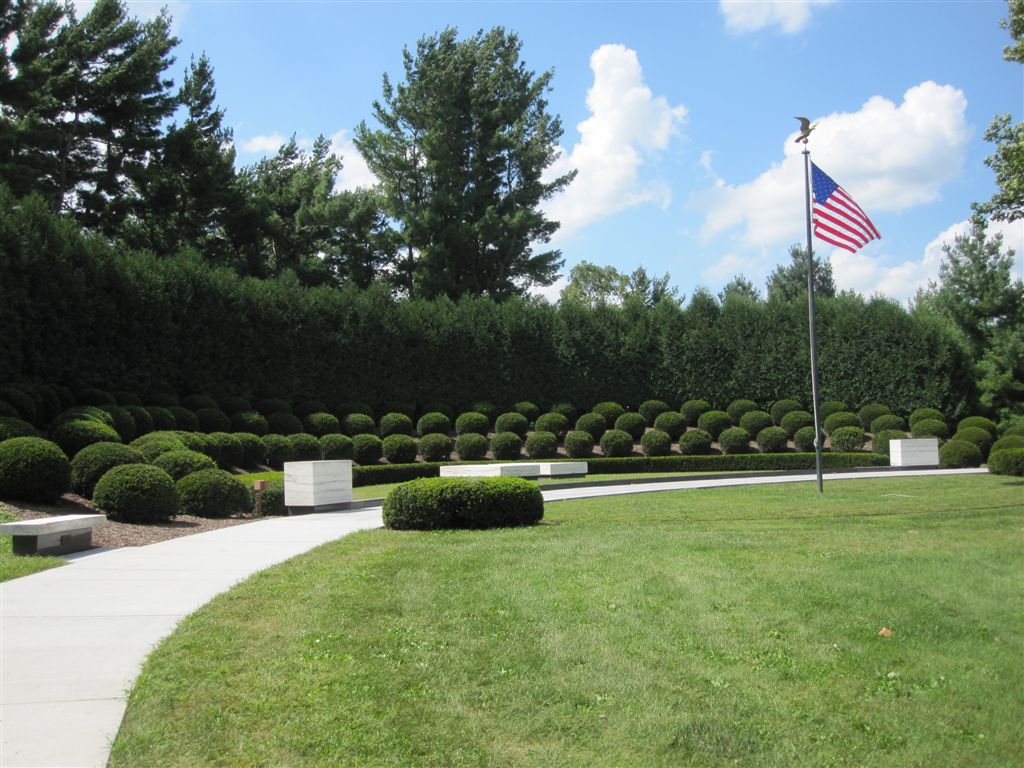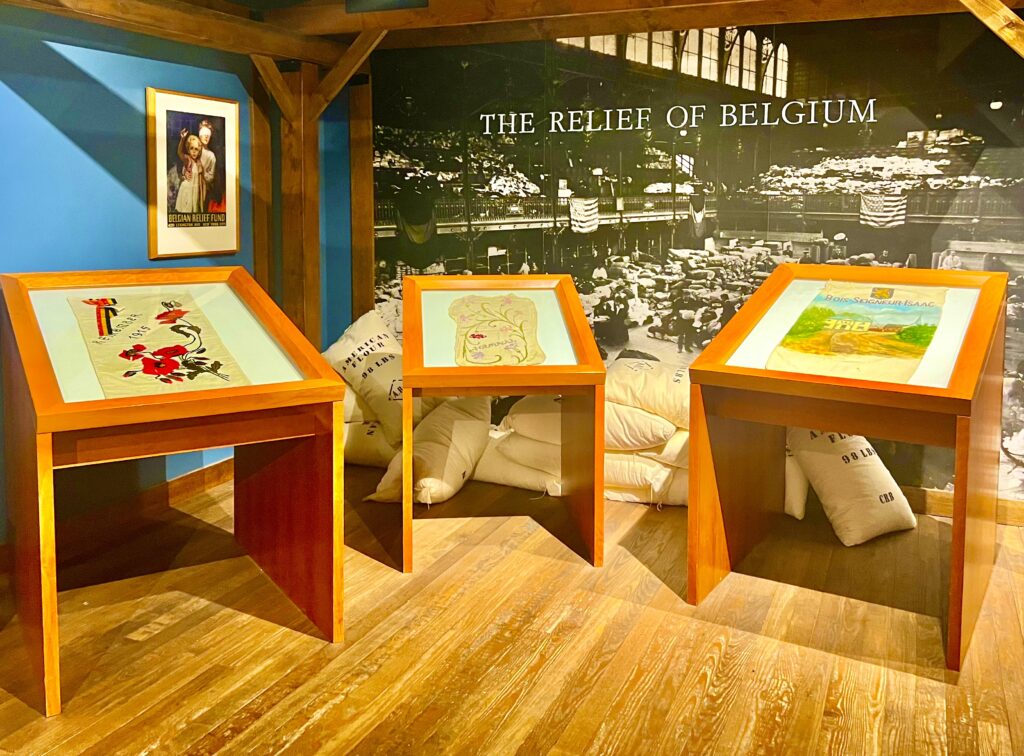The life of Herbert Hoover is reminiscent of a Mark Twain novel, so incredible it’s hard to believe it’s true. Filled with twists and turns, Hoover’s path towards becoming America’s 31st president is fascinating. Born in rural Iowa and orphaned at age 9, Hoover would go on to graduate as part of Stanford’s inaugural class, become a wildly successful mining engineer, and achieve world wide fame for his humanitarian efforts. Yet he is singularly remembered for presiding over the beginning of the Great Depression. With so much of his life overshadowed, everyone can benefit from a visit to Herbert Hoover National Historic Site.

Located in the town of West Branch, Iowa, Herbert Hoover National Historic Site is home to Hoover’s Presidential Library & Museum, as well as his boyhood home and gravesite. His boyhood home is worth a visit. The simple 2 room home is an excellent reminder of his humble roots. Hoover’s gravesite is also worth visiting. Perched atop a small hill and overlooking a section of preserved tall grass prairie, it’s a scenic spot to pay respects to our 31st president. The main attraction though is the presidential museum.

Born in Iowa, Herbert Hoover was our first president born west of the Mississippi River. In fact, Hoover wouldn’t visit east of the Mississippi until he was 22 years old. Orphaned at age 9, he was sent to live with his aunt and uncle in Oregon. In the fall of 1891, he enrolled at Stanford University, becoming the youngest member of its inaugural class. He would go on to graduate at age 20, earning a degree in geology. The museum devotes an entire section to Hoover’s college years, and includes a fair number of interesting artifacts. In isolation, Hoover graduating from Stanford is fascinating. I haven’t done any research, but I assume the odds of an orphan from rural Iowa graduating from college in the 1890’s, were not very good. In the context of his entire life though, Stanford might be the least interesting part of Hoover’s life.
Hoover left Stanford with no money and no immediate job prospects. His first job after graduation, was shoveling ore in a Virginia City mine for $2 a day. In the spring of 1897, a British mining firm was looking for an experienced geologist to manage some of their operations in Australia. The company was looking for someone at least 35 years old, and with “a lifetime of experience”. Hoover just 23 years old, lied about his age, buying a tweed suit and growing a mustache to look older. With that slight of hand, he got the job, and soon found himself in the Australian outback.
Hoover proved himself early on, scouting out what he though would be a promising gold mine. He convinced his employers in London to purchase the land for $1 million. The Sons of Gwali Mine would soon become famous, eventually minting $65 million dollars for Hoover’s very grateful employer. This is the part of the movie where you start to question the plot. Orphan from Iowa strikes gold in the Australian outback? It seems like an unrealistic plot line, but this was the reality of Herbert Hoover’s life.
After just a few short years of success in Australia, Hoover was promoted to partner in the firm of Bewick-Moreing. Just 24 years old, Hoover was sent to China to develop the company’s coal mining operations. While working in China, Hoover witnessed the Boxer Rebellion. For the next several years, his mining career would take him to countries all over the world. Eventually he would strike out on his own, opening a mining consulting business in 1908. I’m obviously skipping over a lot of details, but needless to say, by this point Hoover was extremely well traveled and very wealthy. Perusing the museum, you’ll find all kinds of fascinating artifacts and historical details from this period. .
“I did not realize it at the moment, but on August 3,1914, my engineering career was over forever. I was on the slippery road of public life”
Herbert Hoover
By the time World War I rolled around, Hoover was extremely wealthy, and yearning to make a difference through public service. In a few short years, Herbert Hoover would become known as the “Great Humanitarian”. Initially thrust into public service when the U.S. Ambassador to Britain solicited Hoover’s help, he was tasked with organizing the rescue of the 120,000 Americans trapped on the wrong side of the Atlantic. As part of the effort, Hoover loaned the stranded Americans $1.5 million dollars of his own money. An act of generosity which foreshadowed things to come.
In the fall of 1914, Hoover was asked to lead the Commission for the Relief of Belgium (CRB). The relief effort was a monumental operation, with Hoover organizing mills, shipping, railroads, and factories to get food to Belgium. At times, Hoover personally financed the operation, and several times pledged his entire net worth to support the effort. By the end of the war, Hoover had helped feed 11 million people in Belgium, and was recognized as a hero around the world. One of the coolest displays in the museum, are the flour sacks decorated by the people of Belgium, which were sent to Hoover as a thank you for his relief efforts.

The end of the war only intensified the need for Hoover’s talents. Following the Armistice in 1918, Hoover created the American Relief Administration, with the goal of feeding the war torn nations of Europe. Historians estimate the effort helped feed between 15 and 20 million children throughout Europe. Hoover and the American Relief Administration were also vital to preventing complete famine in Bolshevik Russia. The museum has a separate section devoted to the Russian relief effort. To say that it’s thought provoking is an understatement.
Following a revolution and participation in a world war, Russia was on the brink of collapse. Hoover originally offered aid to Russia in 1919, but Lenin refused, balking at some of Hoover’s conditions. By the summer of 1921, famine was so widespread, that Lenin relented and asked for foreign aid. Hoover responded, and within a year his American Relief Administration was providing daily meals for 10 million people throughout the country. Historians estimate that prior to foreign aid being let in, 5 million people died from famine. Absent significant aid from the United States, millions more would have succumbed to famine throughout Russia.
This was a fascinating and important time in world history, yet anecdotal evidence suggests very few people are familiar with the episode. How would public perception of Herbert Hoover change if his humanitarian work was more widely known? Many are familiar with the Marshall Plan and America’s efforts to rebuild Europe and Japan following WWII, yet the humanitarian efforts following WWI are largely forgotten. I don’t have the answer as to why this is the case, but I do know there are valuable lessons to be learned from this history.
“Before the next harvest the American Relief Administration under my direction, will have expended more than 50 million dollars in American charity on the saving of Russian people from starvation and in providing seed for the next harvest. This operation will perhaps do more than save ten millions of humanity from death. It will through this act of charity have saved the soul of the Russian people from an abyss of despair, too terrible for human expression.”
Herbert Hoover, 1922
From 1921 to 1928, Herbert Hoover served in the Harding and Coolidge administrations as the Secretary of Commerce. In comparison to the rest of his life, Secretary of Commerce seems kind of dull, but Hoover found a way to make it interesting. He pushed for standardization across a broad range of industries, some of which you’re probably familiar with. How about a gallon of milk or carton of a dozen eggs? Prior to Hoover’s standardization efforts, milk was sold in 42 different container sizes. Eggs went under a similar standardization. How about traffic lights? Hoover is the one that standardized the red means stop, green means go system. Pretty decent accomplishments for a Secretary of Commerce.
Not so much an accomplishment as an interesting fact, Hoover was featured in the very first public demonstration of television. You can keep that piece of trivia in your back pocket, it’s bound to be a Jeopardy question at some point. Everyone’s heard of the Hoover Dam, but did you know he also chaired the Colorado River Commission, which determined how water would be divided among the states of the southwest? The commission led to the Colorado River Compact, which to this day determines how water from the Colorado River is allocated.
“Today we have, in a sense, the transmission of sight for the first time in the world’s history. Human genius has now destroyed the impediment of distance in a new respect, and in a manner hitherto unknown.”
Herbert Hoover, 1927
In addition to his work as Secretary of Commerce, Hoover founded the American Child Health Association. As an orphan, Hoover was especially concerned about the needs of similarly situated children. In 1923, one of Hoover’s speeches was slightly modified and published in a magazine as the “The Child’s Bill of Rights”. Children’s health would continue to be a focus once Hoover was elected President, and he made real contributions to children’s lives. This is another area where Hoover’s accomplishments stand in stark contrast to how he’s perceived by the public.
“The ideal to which we should drive is that there should be no child in America that has not been born under proper conditions, that does not live in hygienic surroundings, that ever suffers from under-nutrition, that does not have prompt and efficient medical attention and inspection, that does not receive primary instruction in the elements of hygiene and good health. It is the purpose of these associations to supplant ten policemen with a single community nurse.”
Herbert Hoover, 1922
Have I convinced you that Herbert Hoover was our most interesting president? Orphan, mining tycoon, “Great Humanitarian”, Secretary of Commerce, first man to appear on television. How has this man’s life not been made into a movie? After such an interesting and accomplished life, I suppose President of the United States was the logical next step for Herbert Hoover. In 1928, Calvin Coolidge decided against running for a second term, and Hoover was the logical choice to replace him. Running against New York Governor Al Smith, Hoover won in a land slide, earning 444 electoral votes.
This is the part of the story where you already know what happens. Fast forward less than a year after his inauguration, and you have the Crash of 1929. While remembered as the beginning of the Great Depression, it really wasn’t. It would be several years before economic conditions really deteriorated. But a stock market crash makes for a convenient starting point, so most people associate the Crash of 1929 with the Depression. It’s also worth pointing out that Hoover was warning as early as 1925, that stock market speculation was reaching dangerous levels. He also encouraged the Federal Reserve to take action to curb speculation, but to no avail.
The question of whether Hoover’s response to the Great Depression was correct, is open for debate. Despite what you might hear from the talking heads on TV, the Great Depression is a topic that elicits broad disagreements among economists. Answering the question of what the proper response should have been, is a topic that some economists devote their entire careers to, and opinions vary quite a bit. Through that lens its difficult to judge what Hoover could have done differently, and whether it actually would have worked.
Along those same lines, FDR gets way to much credit for his early economic policies. In fact he did quite a bit to make the Great Depression worse in the early years. It was the outbreak of WWII that brought the United States out of the Great Depression, yet you’ll find no shortage of people espousing the idea that FDR’s economic policies were responsible. Regardless of how much blame he should have shouldered, Hoover became the scapegoat for the country’s economic woes. He stood little chance of reelection in 1932, and lost in a landslide to FDR.

Herbert Hoover is primarily remembered for the tumultuous years of his presidency, but I hope I’ve made the case for why that shouldn’t be the case. Hoover lived a fascinating and accomplished life, and we can all learn something from a broader understanding of his story. I really can’t speak highly enough of the Herbert Hoover National Historic Site. For those of you who get the opportunity, don’t pass up a chance to visit the museum. I’m a fan of presidential museums in general, but Hoover’s is brimming with fascinating information, and well worth a visit.

I had no idea he was poor and an orphan. He had quite a life. Maybe you should write a screenplay about his life and try and get it made into a movie. 🤔